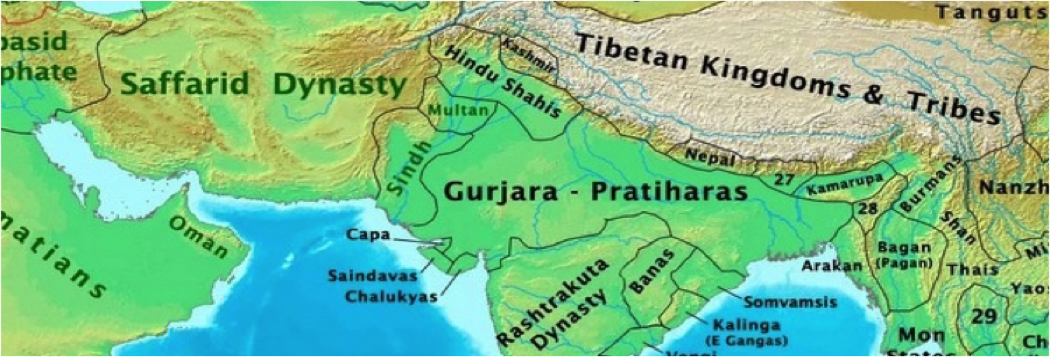
2.The Gurjara – Pratihara -Gujarat
1.The Gurjara-Pratiharas, or simply, the Pratiharas (8th century CE - 11th century CE) held their sway over western and northern India. This dynasty saw its fortunes rising under Nagabhata I (730–760 CE) who successfully defeated Arab invaders. Bhoja or Mihira Bhoja (c. 836-885 CE) was the most well-known king of this dynasty. The Pratiharas were known chiefly for their patronage of art, sculpture and temple-building, and for their continuous warfare with contemporary powers like the Palas (8th century CE - 12th century CE) of eastern India and the Rashtrakuta Dynasty (8th century CE - 10th century CE) of southern India.
The Gurjara-Pratiharas were instrumental in containing Arab armies moving east of the Indus River. Nagabhata I defeated the Arab army under Junaid and Tamin in the Caliphate campaigns in India. Under Nagabhata II, the Gurjara-Pratiharas became the most powerful dynasty in northern India.
Important kings of The Gurjara – Pratihara
The Gurjara-Pratihara dynasty, which flourished from the 8th to the 11th centuries CE, played a significant role in the history of North India. Here are some of the important kings of the Gurjara-Pratihara dynasty:
1. Nagabhata I (730-760 CE)
Founder of the Dynasty: Nagabhata I is considered the founder of the Gurjara-Pratihara dynasty. He established his rule in Avanti (present-day Malwa).
Military Success: He successfully repelled an Arab invasion from Sindh, establishing the dynasty's military prowess and securing the western borders of India.
2. Vatsaraja (775-805 CE)
Expansion: Vatsaraja expanded the kingdom significantly, extending his influence over a large part of North India.
Conflicts: He faced opposition from the Rashtrakutas and the Palas but managed to maintain control over his territories, though he faced setbacks in his ambitions to dominate the Gangetic plains.
3. Nagabhata II (805-833 CE)
Consolidation: Nagabhata II consolidated the gains of his predecessors and extended his kingdom's influence further.
Defeat of the Rashtrakutas: He achieved notable success against the Rashtrakutas and established Kannauj as a major power centre.
4. Mihira Bhoja (836-885 CE)
Greatest King: Mihira Bhoja, also known as Bhoja I, is considered the greatest ruler of the Gurjara-Pratihara dynasty.
Territorial Expansion: His reign saw the expansion of the empire to include large parts of Northern and Central India.
Patronage: He was a patron of arts and literature, and his reign is often considered a golden age for the Pratihara dynasty.
5. Mahendrapala I (885-910 CE)
Expansion and Prosperity: Mahendrapala I continued the expansion and consolidation of the empire, maintaining its prosperity and strength.
Cultural Flourishing: His reign saw continued patronage of arts and culture, contributing to the dynasty's legacy.
6. Mahipala I (914-941 CE)
Defensive Strength: Mahipala I defended the empire against various invasions and internal strife.
Decline: Although he managed to keep the empire intact, his reign marked the beginning of the decline of the Pratihara power due to continuous warfare and loss of territories.
7. Rajyapala (960-1018 CE)
End of the Dynasty: Rajyapala's reign saw the final decline of the Gurjara-Pratihara dynasty.
Invasion by Mahmud of Ghazni: He faced invasions by Mahmud of Ghazni, who plundered Kannauj and weakened the Pratihara rule significantly.
